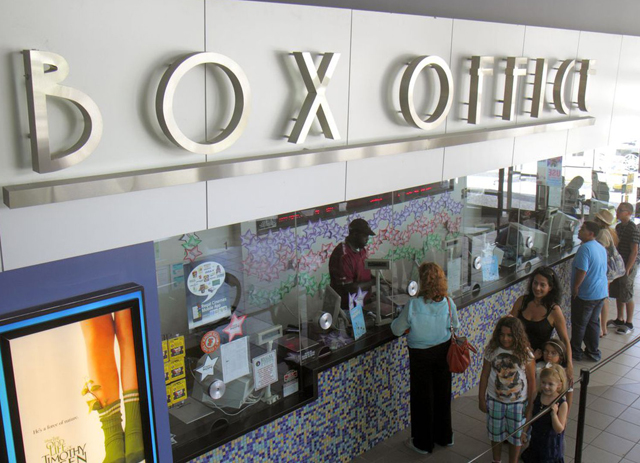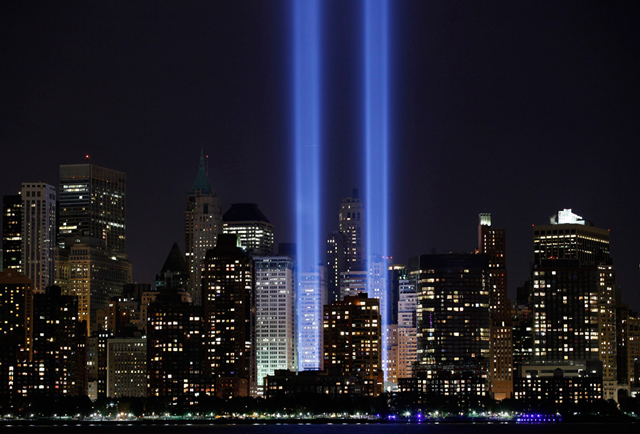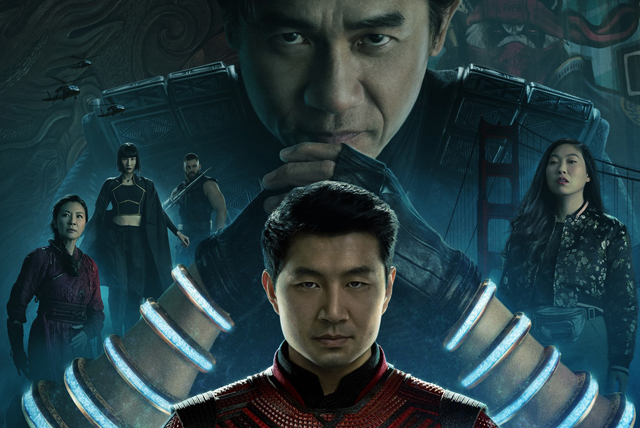
There have been some works of literature that have proved to be too daunting for filmmakers to adapt for the big screen. The works of J.R.R. Tolkien for many years proved to be one of the most notoriously un-filmable projects in the history of film. Tolkien himself let the film rights go almost for nothing during his lifetime, because he was confident that an adaptation could never be done. His immensely detailed fantasy saga, complete with it’s own unique cultures, languages, and deep rooted history that spans over five published novels, just could not be contained within a mainstream Hollywood film. That’s not to say there weren’t many tries. One of the most interesting “what if?” scenarios in movie history was an attempt by the Beatles to adapt Tolkien’s magnum opus, the three volume Lord of the Rings, starring the Fab Four and directed by none other than Stanley Kubrick. The still living at the time Tolkien dashed those hopes unfortunately. After Tolkien’s passing in 1973, the animation duo of Arthur Rankin and Jules Bass took it upon themselves to adapt the first book in Tolkien’s Middle Earth saga, The Hobbit (1977), and it became a beloved classic for both long time fans and young audiences getting their first exposure to Tolkien’s imaginative world. A year later, another independent animator, the provocative Ralph Bakshi, made his attempt at adapting The Lord of the Rings into a film, adapting all of the first book and half of the second into one ambitious film. Unfortunately, this version had a mixed reception and Bakshi was never able to complete his second part. Rankin/Bass instead closed out the saga with their adaptation of The Return of the King (1980), picking up more or less where Bakshi had left off. Though the animated medium managed to bring Middle Earth off the page in a beautiful way, there were many people who still wanted to see Tolkien’s masterpiece fully brought to life in a live action fantasy epic. Eventually, a bold group of filmmakers did finally pick up the torch for that dream and ran with it, finally giving us that grand big screen epic that we always wanted. But, what shocked many people was the person who ended up being the one to deliver on that promise.
New Zealand director Peter Jackson was probably not on anyone’s radar as the man who would bring The Lord of the Rings to the big screen in a big way. Jackson was up until that time known as a schlock horror filmmaker, with titles like Bad Taste (1987), Meet the Feebles (1989) and Dead Alive (1992) to his name. A sudden shift to drama with the critically acclaimed Heavenly Creatures (1994) helped to give him some attention outside his native country, including earning a Oscar nomination for his screenplay, which he co-wrote with his wife Fran Walsh. It was after the warm reception to Heavenly Creatures that Jackson decided to pitch his dream project of adapting The Lord of the Rings to all the Hollywood studios. Eventually, he was granted a development greenlight with Miramax Studios, under the tyrannical eye of future disgraced producer Harvey Weinstein. At the time, knowing that it would take several years to refine the final script and get all the effects up to the level that he needed, Peter Jackson worked on another film called The Frighteners (1996), using it as a test run of sorts for the CGI and practical effects that he would need for The Lord of the Rings. Afterwards, it was full steam ahead. But before the movie could enter it’s final stages of development, namely casting and location prep, Miramax decided to abandon their involvement in the film. Though disheartened, Jackson nevertheless didn’t give up and he was allowed to shop the project somewhere else. Eventually, it found a home at New Line Cinema, the studio behind Freddy Kruger and Austin Powers. Initially, the movie was planned as a two picture deal, but New Line had a different idea. The simply told Peter Jackson this: there are three books that make up The Lord of the Rings; why not make three movies? It was music to Peter Jackson’s ears, and his dream project was now becoming a reality, with the creative freedom to devote an entire film to each of Tolkien’s books. Three films filmed together over an 18 month period was unprecedented, and a huge gamble for both New Line and Peter Jackson. But, as we would soon see, it would be a movie series that would change cinema forever, and is still regarded as a landmark 20 years later.
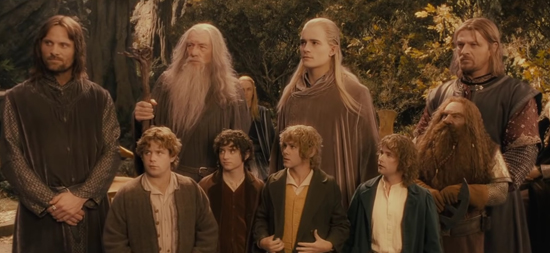
THE LORD OF THE RINGS: THE FELLOWSHIP OF THE RING (2001)
Looking over the trilogy as a whole, it’s important to examine how crucial the first chapter in the series was to everything that followed. It should be noted that The Lord of the Rings is in fact a sequel to Tolkien’s The Hobbit; a sequel that is 5 times the length of it’s predecessor and took Tolkien 19 years to complete. It’s a mammoth story, and one that needs the proper context. Remarkably, Peter Jackson created his Lord of the Rings without the context of a Hobbit to support it (at least initially). This was going to be our first foray into Middle Earth and for Peter Jackson, the crucial thing that he had to get right from the very first start was the world-building in his film. One of the brilliant choices on Jackson’s part was to rethink the whole idea of how to film a fantasy narrative for the big screen. Fantasy films were nothing new to cinema, but many of them were too cheesy and/or obtuse to ever be considered serious cinema. Jackson on the other hand decided to do away with the camp that defined the genre and instead took inspiration from historical epics like Spartacus (1960), Lawrence of Arabia (1962), and Zulu (1964). In his vision, they were filming The Lord of the Rings like they were recreating history, treating their fabricated sets and props like they were on real locations with real swords and armor. That was the approach that he set out to uphold through all three films, and nowhere was it more important that with the first film in the series, The Fellowship of the Ring. From the pivotal opening prologue that sets the stage and onward Peter Jackson takes the audience on a journey, putting them in the middle of a living, breathing Middle Earth. Utilizing the amazing craftsmanship of his crew at the in-house Weta Workshop, Jackson was able to create everything he needed to give his Middle Earth a lived in feel. And to capture the grandiose expanse of Tolkien’s world, he didn’t have to look any further than his own native soil, with New Zealand providing every picturesque location he needed. The Lord of the RIngs would set a new high bar for world-building that would define the next 20 years of cinema.
But, on top of establishing it’s world in such a remarkable way, The Fellowship of the Ring also put the series on solid footing with it’s introduction to the cast of characters. Just as crucial to the series as the work put into creating a believable Middle Earth was finding the right people to play these iconic characters from the novel. And in this regard, the movie managed to aim high and still get the perfect choices for each role. In particular, getting the titular Fellowship was pivotal for the movie’s overall success. Former child actors Elijah Wood and Sean Astin, now in their twenties, landed the highly coveted parts of Frodo Baggins and Samwise Gamgee, the trilogy’s most pivotal set of companions. Iconic Shakespearean actor Ian McKellan was a natural choice for Gandalf the Wizard. Fresh faced character actors Dominic Monaghan and Billy Boyd were cast as the affable duo of hobbits, Merry and Pippin. Soon to be heartthrob Orlando Bloom became the elf warrior Legolas. Renowned character actors John Rhys-Davies and Sean Bean stepped into the parts of Gimli the Dwarf and Boromir the Gondorian knight. Unfortunately, due to creative struggles, the crucial part of Aragorn, the exiled heir to the throne of Gondor, had to be recast at the last minute. To the relief of everyone, actor Viggo Mortensen not only stepped in on short notice, but hit the ground running once he was there. Couple this with a supporting cast that included heavyweights like Ian Holm, Liv Tyler, Hugo Weaving, Christopher Lee, and Cate Blanchett, and you have one of the most astonishing casts ever assembled. Even with big names like these, the movie still puts the world of Middle Earth front and center, taking us from the simple beauty of the Shire, through the majesty of Rivendell, down the perilous passages of the mines of Moria, and onward to the dark realm of Mordor. And at no point does the movie take you out of it’s firmly established world. Peter Jackson succeeded immensely at his goal of making the audience believe that Middle Earth was real and that the characters that inhabit it were worthy enough to follow along on this journey. And with the foundation firmly established in this first chapter, Jackson had to confidence to continue building more with the remainder of the story.

THE LORD OF THE RINGS: THE TWO TOWERS (2002)
The Fellowship of the Ring became an overwhelming success, even in the face of direct competition from another high profile fantasy series released only a few weeks earlier; Harry Potter and the Sorcerer’s Stone (2001). It even earned an unexpected Best Picture nomination from the Oscars, while at the same time snagging a few technical award wins in the process. But, it was only the first part of a three movie arc. In some ways, the second film, The Two Towers, was going to always be the trickiest movie in the trilogy to get right. Like most middle chapters, it’s a story without a beginning or an end. It’s sole purpose is to keep the story moving while at the same time raising the stakes. So, how does Peter Jackson make this middle chapter stand on it’s own? For one thing, he had to find the core of what the story needed to be for this section overall narrative. And not only that, he had to find it while cutting back and forth between two different parallel plot threads. In one, we continue with Frodo and Sam, after they have broken away from the Fellowship to continue onto the realm of Mordor alone in order to destroy the “One Ring,” the ultimate evil weapon in all of Middle Earth. The other, we follow Aragorn, Gimli and Legolas as they search for the kidnapped Merry and Pippin, and find themselves in the Kingdom of Rohan, a horse based society that roams vast open fields of prairie. Within Rohan, we are introduced to a new set of pivotal characters, including the noble King Theoden (Bernard Hill), and his niece and nephew, Eowyn (Miranda Otto) and Eomer (Karl Urban), and a re-awakened purpose begins to bloom in Aragorn as he realizes that Rohan needs help to defend itself. Saraman the White Wizard (Christopher Lee) is acting on the orders of the Dark Lord Sauron, the true owner of the One Ring, and is amassing an army of specially bred monsters known as Urak-hai. With eyes set on Rohan, Saraman’s army pits our heroes in an almost unwinnable situation.
Here, Peter Jackson finds the conflict that defines the narrative of The Two Towers and helps to set it apart. The movie culminates in a grand, epic battle scene at the fortress of Helm’s Deep. It’s here that we find the influence that Peter Jackson drew from historical epics of the past come to full fruition. The Battle of Helm’s Deep is a master class of build-up and payoff in staging a cinematic battle scene. It’s huge in scale, and yet we never feel lost or overwhelmed, as the human conflict remains primarily in focus. And all the tricks of the trade that Jackson and his team refined over the years with practical and visual effects are fully utilized throughout the more than 40 minute battle sequence. Creating the setting of Helm’s Deep itself, which was accomplished through a combination of full sized sets and scale models, is particularly impressive. But, if the movie had an even more groundbreaking accomplishment than Helm’s Deep, it’s something (or someone) introduced in the Frodo and Sam story thread. After being lost in the mountains, the two hobbits encounter another character out to capture the ring for himself; the miserable creature Gollum (played by Andy Serkis). Gollum, an entirely CGI animated character, is a remarkable creation, and became a groundbreaking advancement in computer animation. Never before had it been possible for an entirely computer animated character to coexist alongside live action actors and feel genuinely authentic and capable of delivering a dramatic performance. But with Gollum, the team at Weta Digital managed to do the impossible and turn Gollum into a character that felt shockingly real. It helped that Andy Serkis, who was initially just hired to do the voice, provided motion capture reference for the animators to work with, including several scenes where he was on set interacting directly with the other actors. It’s a tour de force performance that carries through right into the final digital model. One scene in particular, where the dual identities of Gollum and Smeagol carry on a back and forth conversation is an especially memorable highlight. With the groundbreaking work on Gollum and the raised stakes established in the Battle of Helm’s Deep, Peter Jackson not only made The Two Towers stand on it’s own as a movie, but he possibly maybe even made the most impressive film in the entire trilogy, from an execution standpoint.
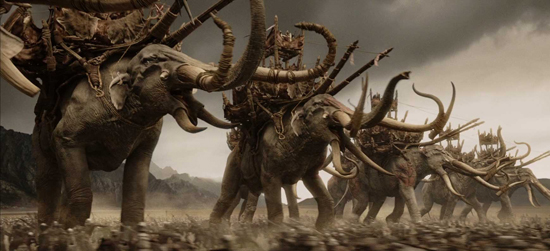
THE LORD OF THE RINGS: THE RETURN OF THE KING (2003)
Of course, the only reason why you make The Fellowship of the Ring and The Two Towers is so you can get to The Return of the King; the climatic finale to Tolkien’s monumental work. And if you look at cinematic inspiration manifested through the trilogy so far, with Peter Jackson channeling David Lean a bit with Fellowship and John Ford a bit with Two Towers, it’s obvious that with Return of the King that he’s going full blown Cecil B. DeMille. The Return of the King is biblical in it’s epic grandeur. Here, Jackson knew that he had to bring everything to the table in his epic final chapter, and that meant utilizing every he and his crew learned up to this point. Leaving the wildness of the Kingdom of Rohan behind, our characters journey forth into the mighty Kingdom of Gondor, and it’s great white seat of power, Minas Tirith, the city of Kings. Minas Tirith was no doubt designed to be the grandest location in the entire trilogy, and most of the final film is set there, with an epic battle taking place outside it’s mighty walls. The Battle of Helm’s Deep was a brutal intimate affair in comparison to the immensity of the Battle of Pelannor Fields. And again, Peter Jackson masterfully never loses sight of the human story taking place amongst the mayhem of the battle. In particular, like all great epic movies that have been building up to something, this movie has bucket loads of moments that make audiences stand up and cheer. There’s the Riders of Rohan charging the battlefield; there’s Aragorn arriving with the army of the dead; there’s Legolas taking down a giant elephant (or Mumakil as they are known in Middle Earth) by himself; and of course Eowyn, who entered discreetly into the Rohan army, slaying the Witch King, who legends say “no man could kill.” More than anything, this is what drove so many epic filmmakers to want to bring this story to the screen for so long; to create a scene of this scale and magnitude come to life. Really, only the biggest possible screens available can do this segment of the movie justice.
But, the Battle of the Pelannor Fields sequence only matters if everything else around it still manages to be engaging. And Peter Jackson manages to stick the landing for the most part. The emotional core of Frodo and Sam’s journey into darkness as they head deep into Mordor and up the slopes of Mount Doom where the ring was originally forged. Even though it’s a simple story thread in comparison to what’s happening on the outskirts, it probably packs the biggest emotional wallop of any part of the trilogy. Elijah Wood in particular perfectly encapsulates the deteriorating state of Frodo both physically and mentally, as being the Ringbearer takes it’s toll on him. Likewise, Sean Astin does a remarkable job of conveying the limitless sense of loyalty that Sam devotes to Frodo. The scene where Sam lifts Frodo onto his back after they’ve reached a breaking point, declaring “I can’t carry the ring for you Mister Frodo, but I can carry you,” is one of those cinematic moments that’ll make grown men cry in a theater, along with most everyone else. And it leads to the climatic end that we’ve waited two and a half films for; the destruction of the ring and the triumph over evil. Even here, Peter Jackson keeps upping the ante of epic grandeur, with the destruction of Sauron and Mordor taking on Biblical proportions. Beyond that, a protracted denouement concludes the trilogy. Some have complained that it’s too many endings, but when you see it as finale to a three film narrative arc, the lengthy epilogue makes a lot more sense. It is particularly refreshing to see Peter Jackson stick closely to Tolkien’s final chapters, including the very final words spoken, “Well, I’m home.” It’s a simple, innocuous statement given the story that preceded it, but it’s a sentiment that mattered a lot to Tolkien himself. J.R.R. Tolkien went through hell when he fought in the trenches of the First World War, losing friends along the way. For him, the feeling of returning home through all that trauma was a very profound thing for him, and it’s something he carried throughout his life. For him, home was life, and recognizing the value of what it meant to go back home is what propelled him to fight harder for the things he loves. That, in essence is what the story of The Lord of the Rings is all about; finding the will to live, and fighting to make your way home. For all of us, we must make our own ventures into Mordor if we are ever to come home to the Shire. And that’s why Jackson knew it was the perfect note to close out his epic trilogy on.
There really is no other way to look at the entirety of The Lord of the Rings trilogy than to see it as one of the greatest cinematic success stories of all time. Not since Star Wars had a movie franchise captured the imagination of audiences so immensely and changed the face of cinema as a result. It removed the stigma that surrounded the fantasy genre in Hollywood; so much so that The Return of the King made history as the first fantasy film to ever win the Best Picture Academy Award, along with tying Ben-Hur (1959) and Titanic (1997) for the most awards won in a single night, with 11 in total. Even twenty years after it first launched, The Lord of the Rings is still the high water mark for fantasy in Hollywood, and even a highly influential benchmark in epic filmmaking in general. You can see it’s footprints even in something like Avengers: Endgame (2019), particularly with the staging of it’s battle scene. There was even a brief proliferation of new fantasy franchises that sprung up in the wake of The Lord of the Rings, though few managed to make it past a single film. Tolkien’s contemporary C.S. Lewis and his Narnia series almost came close to capturing the same success, but it unfortunately ran out of steam after three films in a planned seven story arc. Though The Lord of the Rings stood spectacularly on it’s own, there was demand for many years for Peter Jackson to return to Middle Earth with an adaptation of The Hobbit, which did eventually happen, but that’s a story worthy of it’s own article. Looking back on The Lord of the Rings trilogy as it marks 20 years since it’s beginning, I can tell you personally that this trilogy had a profound effect on me. I had already begun to get interested in filmmaking at that point, as I was entering my college years at the time, and the trilogy became a flash point moment in re-affirming my dream to be a part of the movies. The movies themselves were glorious experiences, but what I loved the most was the fact that Peter Jackson went out of his way to document the process with which he made these movies. The Collectors Editions of the trilogy that were released on DVD are remarkable for the breadth of their behind the scenes supplements. Many have commented that they are essentially a film school in a box, and it’s easy to see why. From concept, to script, to principle photography, to final edit, every step of the films’ making are chronicled in these DVD box sets. It makes you wonder how many filmmakers of this generation were inspired just by pouring through all the features on those sets. Peter Jackson changed cinema forever by breaking down the conventions of genre, sparing no expense, and also by providing a compelling window into the process itself after we see the final films. The Lord of the Rings not only does justice to Tolkien’s monumental work, but it also stands as a shining example of filmmaking at it’s absolute peak. It’s a trilogy that really is worth going “there and back again.”
